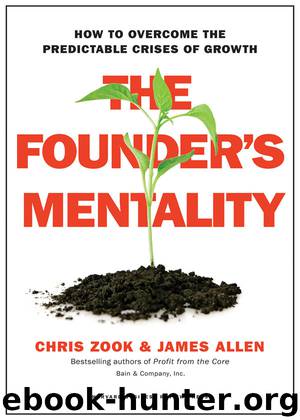The Founder's Mentality: How to Overcome the Predictable Crises of Growth by Chris Zook & James Allen

Author:Chris Zook & James Allen [Zook, Chris]
Language: eng
Format: epub, mobi
ISBN: 9781633691179
Publisher: Harvard Business Review Press
Published: 2016-06-07T06:00:00+00:00
Rediscover the Insurgency of the Past
When companies shrink themselves to regroup, redeploy, and grow, they often rediscover the power of the original insurgency and develop a renewed commitment to pursuing it. That’s what happened with Perpetual, Australia’s oldest trust company, which achieved rebirth by reducing operating cost by 20 percent and stripping away noncore businesses. The result, one industry observer has noted, was “the largest transformation in Australian financial-services history.”
Perpetual was founded in 1886 to manage trust and estate activities for Australia’s wealthy elite, and it did this very well, quickly becoming the largest such firm in the country. For more than a century, the company remained the leader in the Australian market, but as it grew, it diversified into eleven new business areas, and by 2011, as it headed toward its 125th anniversary, the company was struggling. Its stock price had fallen from a high of $84 per share to $19—an 80 percent drop in only five years. Profits were down by 75 percent, with no bottom in sight. Shareholders were calling publicly for major overhaul, and the company was on its third CEO in twelve months, Geoff Lloyd.
Lloyd was deeply concerned at the state of the company when he arrived. He told us:
I found an organization that was internally competitive and externally cooperative, when it should have been the other way around. We were focused too much on internalizing the reasons we were not growing and assigning blame, instead of being out with clients helping them become more competitive. We had grown incredibly complex over time by entering more businesses, eleven in total, and were not the leader in most of them. We did not seem any longer to have a long-term strategy, and no one could agree on where we wanted to go. The unsuccessful diversifications had caused us to lose our confidence. We were awash in complexity and had become hesitant, internally focused, and uncertain as an organization. That made us slow to decide and slow to react. We had little time to right the ship after such a long period of underperformance. Moreover, there was the additional pressure of private equity firms zeroing in on the company. We had to be transformational and not incremental.
Lloyd undertook some initial fact-finding and concluded that to save Perpetual, he would have to return the company to its core mission, as defined more than a century ago by its founders: the protection of Australia’s wealth. To achieve that goal, he realized, he would have to make the company “faster, more confident, and, above all, simpler,” and to do that he would have to resort to immediate “open-heart surgery.”
Lloyd began by replacing ten of the eleven members of the management team with people who did not have a vested interest in the decisions of the past. With his new staff in place, he launched Transformation 2015, a set of five main initiatives overseen by a special program office, designed to bring about radical and swift complexity reduction at all levels.
Download
The Founder's Mentality: How to Overcome the Predictable Crises of Growth by Chris Zook & James Allen.mobi
This site does not store any files on its server. We only index and link to content provided by other sites. Please contact the content providers to delete copyright contents if any and email us, we'll remove relevant links or contents immediately.
Bad Blood by John Carreyrou(6274)
Rich Dad Poor Dad by Robert T. Kiyosaki(6174)
Principles: Life and Work by Ray Dalio(5957)
Playing to Win_ How Strategy Really Works by A.G. Lafley & Roger L. Martin(5491)
Management Strategies for the Cloud Revolution: How Cloud Computing Is Transforming Business and Why You Can't Afford to Be Left Behind by Charles Babcock(4438)
The Confidence Code by Katty Kay(4034)
Thinking in Bets by Annie Duke(3995)
American Kingpin by Nick Bilton(3504)
Delivering Happiness by Tony Hsieh(3280)
Project Animal Farm: An Accidental Journey into the Secret World of Farming and the Truth About Our Food by Sonia Faruqi(3015)
The Power of Habit by Charles Duhigg(2964)
Brotopia by Emily Chang(2892)
Mastering Bitcoin: Programming the Open Blockchain by Andreas M. Antonopoulos(2890)
The Tyranny of Metrics by Jerry Z. Muller(2846)
I Live in the Future & Here's How It Works by Nick Bilton(2844)
The Marketing Plan Handbook: Develop Big-Picture Marketing Plans for Pennies on the Dollar by Robert W. Bly(2792)
The Content Trap by Bharat Anand(2778)
Building a StoryBrand by Donald Miller(2754)
Applied Empathy by Michael Ventura(2749)
